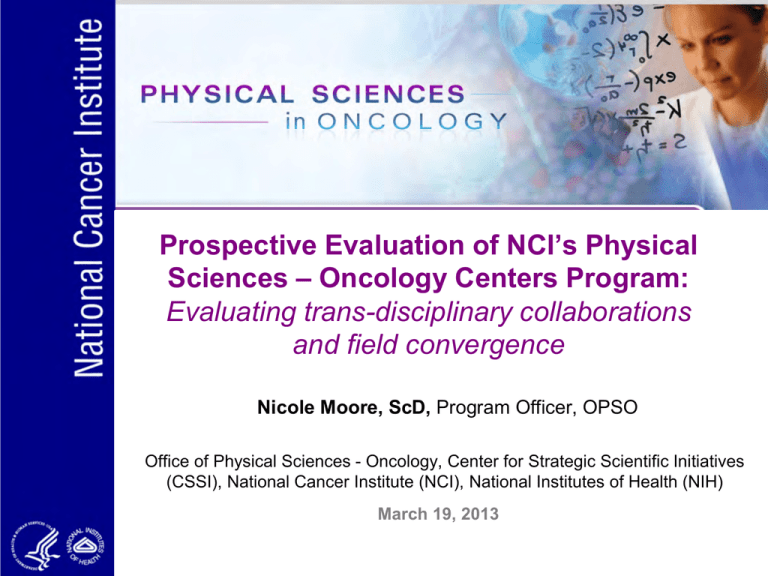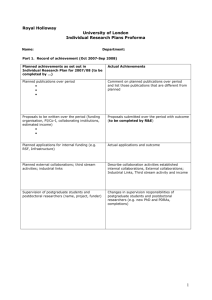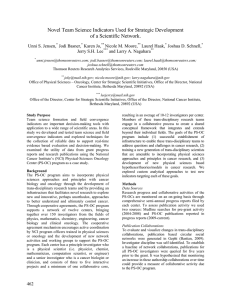Prospective Evaluation of NCI`s Physical Sciences — Oncology
advertisement

Prospective Evaluation of NCI’s Physical Sciences – Oncology Centers Program: Evaluating trans-disciplinary collaborations and field convergence Nicole Moore, ScD, Program Officer, OPSO Office of Physical Sciences - Oncology, Center for Strategic Scientific Initiatives (CSSI), National Cancer Institute (NCI), National Institutes of Health (NIH) March 19, 2013 Physical Sciences-Oncology Centers (PS-OC) Program 2009-2014 FY09 FY14 Phase I Pre-Award Phase I – Physical Sciences - Oncology Centers: Bringing a new, ‘physical sciences perspective’ to cancer research. 12 U54 PS-OCs 100+ institutions and 600+ investigators worldwide 8 of 12 PIs new to NCI Future PS-OC Scientific Themes: Physics (Physical Laws and Principles) of Cancer Evolution and Evolutionary Theory of Cancer Information Coding, Decoding, Transfer, and Translation in Cancer De-convoluting Cancer’s Complexity Physical Sciences Perspective Basic Biology Research Basic Cancer Research Cancer Technology Research Cancer Research w/ Clinical Implications Pre-Clinical Clinical PS-OC Program Goals The Specific Goals for the PS-OC Program: Build trans-disciplinary teams and infrastructure to better understand and control cancer through the convergence of physical sciences and cancer biology. To generate new knowledge and catalyze new fields of study in cancer research by utilizing physical sciences/engineering principles to enable a better understanding of cancer and its behavior at all scales. Not looking for new tools to do “better” science, but new perspectives and approaches to do paradigm-shifting science that will lead to exponential progress against cancer. New – “Schools of Thought” PS-OC Program Structure: Interactions inside and outside of network PS-OC Network External Research Communities PS-OC Organizing Framework Project 1 Project 2 Project 3 Project 4 Core B Core A Education and Training Unit Pilot Projects Trans-Network Admin Unit Core B Core A Project 1 Project 2 Project 3 Project 4 Trans-Network Admin Unit Pilot Projects Organizing Framework PS-OC Outreach Projects TransNetwork Projects Trainee Exchange Education and Training Unit Outreach and Dissem Unit Outreach and Dissem Unit Outreach Projects PS-OC Program Evaluation Plan Recommended by STPI in 2009 “Given the groundbreaking nature of PS-OCs, it is expected that ongoing evaluation….will be needed to assess progress of developing physical science-based frameworks.” -PS-OC RFA Concept (2008) Logic Model Recommended by STPI in 2010 PS-OC Program Evaluation 2009 - 2013 Prospective Evaluation Structured Evaluation Analysis for “in-the-moment“ program improvement Preliminary outcomes after 3 years of operation • Prospective evaluation plan developed in collaboration with GAO, NIAID, DPCSPI, OSPA, and STPI • Logic model and progress report structure developed with STPI • • Data collected via semi-annual progress reports Development of new metrics, indicators, and tools for monitoring progress toward program goals with Discovery Logic • Partnered with NSF and NIBIB to evaluate the state of the physical sciences in oncology portfolio • Survey of ~400 individuals from physical sciences in oncology and broader scientific community • Independent panel evaluation by non-PS-OC affiliated NCI and NIH experts PS-OC Prospective Evaluation Data collection 1. Semi Annual Progress Reports (PHS 2590) Progress of research towards aims All personnel list Publications, Presentations, Patents List of trainees (w/ discipline) Student exchanges and transitions New collaborations within Center, within Network, or outside Network 2. Web of Science (Bibliometric Information) 3. Additional information provide by Program Officials 84 Progress Reports Collected to Date (7 per Center) PS-OC Prospective Evaluation Data Model and Processing Challenge: Organize and structure data for monitoring and analysis in real-time • Data model developed for visual representation of the structure of the progress report data • Used to formally describe data relationships • Used to design SQL database for data storage Example relationships: • Which people contributed to a project? • Which projects does a progress report identify? • Which publications has a person written? PS-OC Prospective Evaluation iTRAQR Interdisciplinary Team Reporting, Analysis, and Query Resource (iTRAQR) Data Entry User Interface Analysis User Interface • Stores data entered through the Data Entry User Interface • Entered data can be queried to support charting and data export in the Analysis User Interface SQL Database PS-OC Prospective Evaluation Example metrics and indicators • • • • • Investigators and Trainees Network and Center Collaborations Bibliometrics (Impact Factor, Citations) Trans-Disciplinary Authorship Collaborations Field Convergence (Physical Sciences/Oncology) PS-OC Prospective Evaluation Data outputs Trainees Growth of the PS-OC Network 400 350 300 250 200 150 100 50 0 Landscape and Number of Collaborations Post-Doc Grad Undergrad Other Year 03 Year 01 Jan Jun Dec Jun Dec Jun Dec 2010 2010 2010 2011 2011 2012 2012 Average Publication Count Per Collaboration Effectiveness of PS-OC Program Elements on Collaboration Outputs 4 3.5 3 2.5 2 1.5 1 0.5 0 Range of Training Opportunities 20 3.38 15 10 0.69 0.79 0.23 5 17 0 15 8 4 0 Research Projects Cores TransPilot Outreach Network Projects Pilot Projects Projects Courses Hands-On Symposia Training Journal Clubs Trans-Disciplinary Collaborations Analysis of authorship collaborations PS-OC Investigator Collaborations Pre-Award (2006-2008) vs. Post-award (2009 - present) 25 per year Node: Network PI (Physical Scientist, Oncologist) Line: Network Co-authorship PI pair (PS-PS, OC-OC, PS-OC) Trans-Disciplinary Collaborations Analysis of authorship collaborations PS-OC Investigator Collaborations Pre-Award (2006-2008) vs. Post-award (2009 - present) 25 per year 62 per year Analysis of Collaborations Pre-award 29% Post-award 24% 32% 46% 47% 22% Physical Sciences PIs Physical Sciences & Cancer PIs Cancer PIs Node: Network PI (Physical Scientist, Oncologist) Line: Network Co-authorship PI pair (PS-PS, OC-OC, PS-OC) 17% increase in percentage of trans-disciplinary authorship collaborations since the start of the PS-OC program Field Convergence Physical sciences & oncology fields PWS FEA SMR Hypoxia PS-OC Network “Ingredients” Death Monte Protein Galaxy MS Carlo Chip-Seq RESIC AFM model SILAC PET Microrray nanofabrication Motility Karyotyping TIRF MRI BIN ab initio IHC Game Theory ChIP-on-chip Stochastic FISH DIC Behavior EM TFM Automata FCM JUMNA IVM Theoretical / Computational Physics Trans-Disciplinary Research Output CT model Evolution Single cell Dynamics epigentics Bayesian Cell CT Network Field Convergence Field Convergence Development of indicator using publication content Journal Category Physical Sciences Terms Physical Sciences Journals Cancer Journals Publications Publications 1,643 571 Content Analysis on Titles/Abstracts Terms Terms Term Filters Physical Sciences Terms Cancer Terms Cancer Terms Field Convergence Analysis of Trans-disciplinary publications by topic 100% Trans-Disciplinary Publications (%) 90% Start of PS-OC program (September 2009) 80% 70% 60% 50% 40% 30% 20% 10% 0% 2004 2005 2006 2007 2008 2009 2010 2011 2012 Year 30% increase in percentage of trans-disciplinary publications during PS-OC grant years Data analysis through June 2012 Field Convergence Breakdown by investigator discipline Physical Scientists Cancer Researchers 80% 100% Baseline (2004-2008) Grant Years (2010 - 2012) Baseline (2004-2008) Percent Publications Percent Publications 100% 60% 40% 20% 80% Grant Years (2010 - 2012) 60% 40% 20% 0% 0% PS OC PS-OC Publication Category OTHER PS OC PS-OC Publication Category OTHER Both physical scientists and cancer researchers have increased the percentage of trans-disciplinary publication output during the grant years Prospective Evaluation Impact on Program • Direct feedback for investigators • 17% of projects have undergone PI initiated changes • Increased reporting quality • Increased Center connectivity • Direct feedback for Program Officials • Ongoing comparison of Centers • Change program elements (ex. Outreach pilot projects) • More emphasis on cancer researchers applying physical sciences principles Physical Sciences in Oncology (physics.cancer.gov) More Information Larry A. Nagahara, Ph.D. Email: larry.nagahara@nih.gov Nicole M. Moore, Sc.D. Email: nicole.moore@nih.gov



